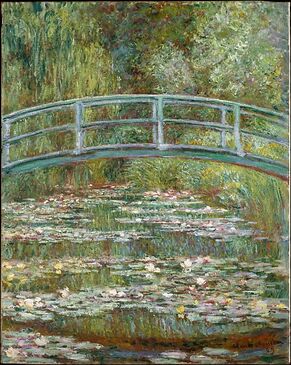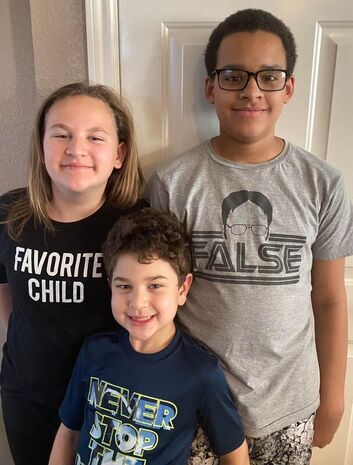 Back in March, I was looking for things to keep me occupied during quarantine. I've always loved puzzles, so I went to Amazon and there was nothing available but kitty-cats with balls of yarn, dogs of many breeds and cutesy cartoon images. Looking for something a bit more stimulating, I visited the website of the Metropolitan Museum of Art in New York and made two purchases: a 500-piece puzzle with tiny images of many famous paintings and a 1,000-piece Monet's Bridge Over Waterlilies number. I commandeered the end of the kitchen table, stole a lamp from the bedroom to provide illumination for the task at hand and began to laboriously flip over the 1,000 pieces, a task which took me most of an afternoon. I quickly discovered that other than the bridge and the waterlilies below it, everything was green. Good grief, what have I done. First, I separated the pieces with one flat edge to form the border. This took forever, but I finally managed to get it completed, all except for 3-4 pieces I couldn't find. I looked on the floor, in the box and they were nowhere. The next day, I looked at the puzzle and the border was complete. I suspect my husband, who is prone to trickery and deceit, may have held them out to gaslight me and finished the frame while I was out, but I have no proof. Then I started in on the bridge. There are three rails curving over the pond and it was challenging to figure out which piece went with which rail. I finally completed most of it and attached it to both side of the frame. I had sorted out the waterlily pieces and began to assemble them in long strands, not knowing which direction was up or down or how they might connect to the frame or to each other. Months went by. The best I could do was to put in about 5-6 pieces at a time without going blind. You see, the pieces of this darned thing were quite irregular in size and shape. I'd estimate it took me at least 15 minutes to identify each piece, examining everything spread out around the frame to find a matching color and shape. With the green pieces, and I'm talking hundreds of shade of that color, it was mostly shape. By this time, I had an epic case of buyer's remorse and considered dumping the whole thing back in the box, but as they say, "she persisted." Six months later, the puzzle is only about two-thirds complete. I've ramped up productivity and am now putting in more pieces at a time, since there are fewer to evaluate. I estimate that it may be Halloween before I can declare victory over this monster. It has given me a new appreciation for Claude Monet, as I can see the thousands of brushstrokes and various colors it took to produce this masterpiece, one of about 250 he painted of waterlilies. Next time around, it may just be a cute brown dachshund puppy playing with a ball, something I could complete in less time than it takes to have a baby.
1 Comment
I miss good manners. I'm sure if I revealed my feelings on this subject to anyone under the age of 30, they would laugh out loud. As a teenager, I used to pore over my mom's Emily Post Etiquette Book to learn what was expected in social situations. I remember going to dancing classes at the high school. In addition to learning the fox trot and waltz, we were expected to observe the social niceties of dressing up, shaking hands and being polite. When I was in college, the food service started the tradition of a steak and lobster dinner once a month. In order to be admitted to this Saturday event, both men and women had to dress like they were going to church. The resulting atmosphere was amazingly civilized.
When I got married, my mother was all over me about proper manners. On the way to a bridal shower at the home of one of her friends, she admonished me to "act like a bride." I think she meant squealing in delight over each gift, which was not exactly my style, but I did my best. Thank-you notes for these gifts were to be in the mail within a few days. Same for wedding presents. When we returned from our honeymoon, there was intense pressure from her to get those notes out even though I was teaching full-time and there were about 200 to write. Flying seems to reveal the worst of manners. People are just plain rude, jockeying to get their ridiculously stuffed bags in the overhead compartment. You see passengers in flip- flops, sleeveless T-shirts and ripped jeans. Parents let their kids kick the seat in front of them and generally act obnoxious. When I worked in the development office of a large children's health system in Delaware, we put on an annual gala, including a sit-down dinner, for 700 people. It was a huge amount of work for our staff. We found that people fell into one of these categories: 1. They were attending. 2. Not attending but showed up anyway. 3. They said they were coming but didn't. It usually balanced out, but caused a lot of angst and running around for the person responsible for seating. Most women came in beautiful long gowns, but there were always a few who attracted attention with a dress that was way too revealing or shouldn't have been worn by them in the first place. I have only a couple of friends who send written thank-you notes or letters. Now these communications are often phone calls, texts or emails. Something has gotten lost in our digital world. One quality I admired in the elder George Bush was that he hand-wrote dozens of personal notes each day. Call me old-fashioned, but I'm finding that my mother was right about manners and their importance in a civilized world. So there. In a rare visit to the library, a book caught my eye. Elderhood was written by Louise Aronson, MD, a geriatric specialist from San Francisco who is in her fifties. She quotes many historical references about what age was considered old centuries ago. Of course, people did not live as long when medical treatments were few and nutrition not as good. Although people begin to age much sooner in life, Dr. Aronson categorizes the beginning of "old" at around sixty. In the United States, we are eligible for Medicare and Social Security benefits at 65 or so. Many people retire at that age.
I worked until I was 69 years old, and was planning to work another year in the development office of a children's health system in Delaware. At the urging of my daughters however, I decided to retire so we could move to Texas and help care for our new grandson. We lived with Hannah and her family for more than a year and then bought a nearby one-story house so we didn't have to cope with stairs. It is my fervent hope that we can stay here for a long time. On Halloween this year, I will turn 75. Thing is, I don't really feel that old. Surgery corrected some serious problems with my lumbar spine and I have much more stamina than before. I take care of laundry, cooking and other household tasks with little effort. My dachshund Toby and I walk a couple times each day and I've just started riding a few miles on a recumbent bike to get my heart rate up and my legs pumping. We take care of our grandchildren on a regular basis, especially Noah, an energetic six-year-old, and are the family Uber and errand doers when needed. However, I am well aware that my health, or that of my husband Andy, could change in an instant. A bad fall, stroke or heart attack could quickly change the trajectory of our lives. But I try not to think about that too much. Dr. Aronson's book points out that most people in their sixties, seventies and eighties actually find this time of life fulfilling and satisfying. By this time of life, you have accumulated knowledge, expertise and wisdom and have the joy of sharing these experiences with others. For me, that feels true. I've had a long, happy marriage, raised three great kids, had a wonderful career in health care fundraising, and are now enjoying being close to our daughters and grandchildren. I still love writing and occasionally get some freelance work from my former employer and the designer I worked with for years. Our health is pretty decent and we enjoy, as a friend of mine would say, just "being." When you get into your seventies, you no longer have the stress of raising kids and/or a demanding job. You can sleep late and take a nap if needed. I love having the time to read, write, do puzzles and play games on my phone. Recently, I completed a project which was great fun: assembling the biographies of my high school classmates. I was fascinated to see what others had done with their lives. Of our class of 96 people, 21 had passed away. About half of the surviving members, all now age 75 or so, participated. This group included doctors, lawyers, writers, veterans, authors, entrepreneurs, business people, educators, real estate agents and pilots. A few were still working full-time. At 75, you do have aches and pains, especially when you get out of bed in the morning. You may be coping with illnesses such as heart disease, cancer, diabetes or orthopedic problems (like me). But life is definitely still worth living, especially if you have the joy of grandchildren and time to pursue what you love, whether that is work or a hobby. Too many of my loved ones and colleagues will never get that chance. So as I move into what Dr. Aronson describes as the "old-old" period of life, I'm still a happy person, grateful for each day on the planet. Yes, we're still staying put, avoiding everything but some appointments in the last couple weeks. I've kind of gotten used to it, but like everyone, I'm wondering when this will ever end.
|
AuthorI'm Chris Barabasz, retired from a 35-year career managing communications for health care development (that's fundraising for you civilians). I'm a wife, mother, grandmother and freelance writer. My husband Andy and I moved from Delaware to Texas to be closer to our daughters and three adorable grandchildren. Archives
January 2024
Categories |

 RSS Feed
RSS Feed